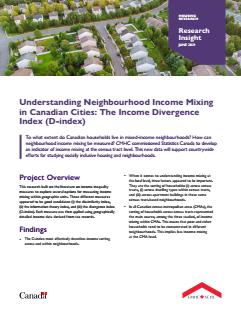The objective of the Indicators of Neighbourhood Income Mixing Project is to develop income-based measures of social mixing designed to measure the diversity of income levels. Income mixing is measured across neighbourhoods and multi-unit apartment buildings. The linkage to Canadian Housing Survey responses offers a new opportunity to examine the relationship between income mixing and policy relevant outcomes, such as dwelling and neighbourhood satisfaction.
3 different measures appeared to be good candidates:
- the dissimilarity index
- the information theory index
- the divergence index
Each measure was then applied using geographically detailed income data derived from tax records.
Findings include:
- The divergence index most effectively describes income sorting across and within neighbourhoods.
- When it comes to understanding income mixing at the local level, 3 factors appeared to be important. They are the sorting of households:
- across census tracts
- across dwelling types within census tracts
- across apartment buildings in these same census tract-based neighbourhoods
- In all Canadian census metropolitan areas, the sorting of households across census tracts represented the main source, among the 3 studied, of income mixing. This means that poor and richer households tend to be concentrated in different neighbourhoods. This implies less income mixing at the CMA level.
- Author:
- CMHC
- Document Type:
- Date Published:
- August 12, 2021







 Share via Email
Share via Email
